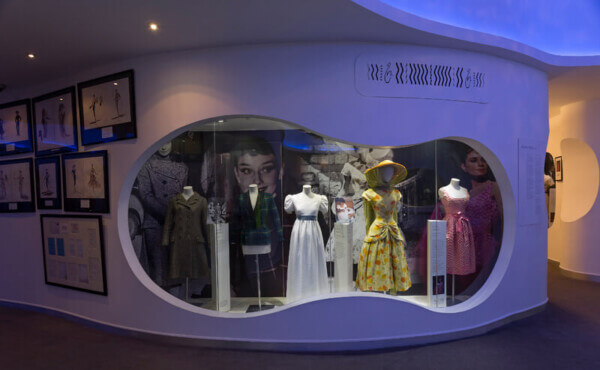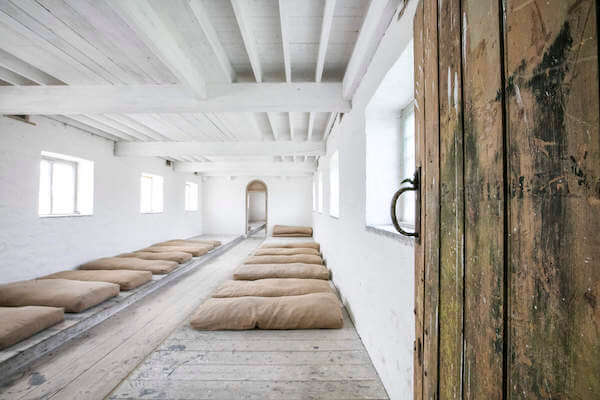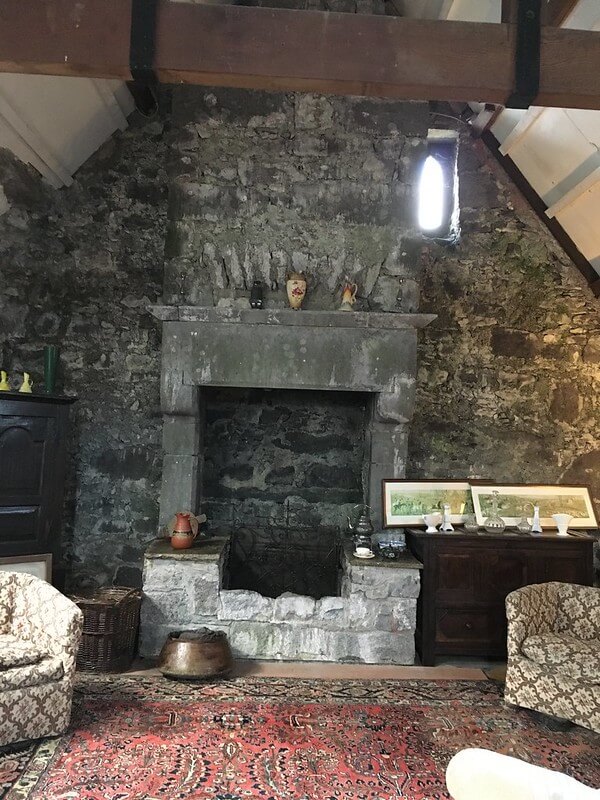Have you ever driven from Dublin to Galway in three days?
 This post contains affiliate links, and I may earn compensation when you click on the links at no additional cost to you.
This post contains affiliate links, and I may earn compensation when you click on the links at no additional cost to you.
The journey, if done in one day, would typically take about 2 hours and 45 minutes.
But this one is intended to take much longer, allowing you to stop off at places along the way, most of them in a region of Ireland known as The Midlands.
To complete this journey, you'll need a rental car.
Most tourists to Ireland rent a car at either Dublin Airport or Shannon Airport.

DAY #1: Castletown House, Celbridge, Co. Kildare
Leave Dublin early in the morning to get a head start on your Dublin to Galway in three days adventure.
The first stop is about a 28-minute drive from Dublin.
Off the M4 highway, take Exit 6 for Castletown House, an imposing Palladian estate located in the County Kildare countryside.
If it’s your first time in Ireland, this wonderful mansion, part of a 550-acre estate, is a great introduction to the kinds of period homes you’ll see throughout the country.

They are a reminder of Ireland’s colonial past and a peek into the lives of its landed Anglo-Irish class.
Such homes sprung up all over Ireland from the late 16th century onwards, with some of them eventually destroyed or attacked during the revolutionary period of the early 20th century in defiance of British rule.
Castletown House, the largest of its kind in Ireland, was built between 1722 and 1729 for William Conolly, the Speaker of the Irish House of Commons.
It is currently under the management of the Office of Public Works.
The lavishness of this fine mansion will leave you in awe.
No expense was spared in the construction of Castletown House, which can be seen by guided tour only.
They run hourly from 10 a.m. until 4:30 p.m. Tickets can be purchased on-site at the reception desk in the west wing near the cafe.
Groups of 8 or more must book in advance by emailing [email protected].
Marvel at the grand entrance hall, which is two stories high, with a polished limestone floor and a marble fireplace made of Kilkenny marble.

The staircase, one of the largest cantilevered staircases in Ireland, has a solid brass balustrade, with opulent Rococo plasterwork and other decorative architectural features overhead.

Seventy-minute guided tours are available and include a walk through the spectacular entranceway, the ground-floor reception rooms, the first-floor Boudoir, the Long Gallery, and the Berkeley Costume Exhibition.

The house is open for tours from March through November. Tours start at 10 a.m. and are provided every hour on the hour. The last tour of the day is at 4:45 p.m.
The restored 18th-century-designed parklands and river walks are open year-round.
Lunch: The Castletown Inn, Celbridge, Co. Kildare
A bright and airy pub, this is the perfect place for a bite to eat after a few hours exploring Castletown House.
A full Irish breakfast is available all day, as well as a variety of starters, salads, burgers, main courses, desserts, and more.
Tourist Attraction: Newbridge Silverware Visitor Centre, Newbridge, Co. Kildare
No visit to County Kildare is complete without a visit to the beautiful Newbridge Silverware Visitor Centre.

The center is a 30-minute drive south on the N7 from the Castletown Inn.
Before you feast your eyes on the beautiful gifts, including the exquisite Newbridge jewelry, be sure to see the Museum of Style Icons, which is housed within the center.
This is a treasure trove of beautiful garments and accessories worn by some of the world’s best-known celebrities.
The collection was started by the company’s CEO and it has grown since it was established in 2006.

Some of the items you’ll see on display include a Givenchy-designed dress worn by the late Princess Grace on her visit to Ireland in 1961 and during her visit to the White House that same year; the world’s largest collection of Audrey Hepburn and Marilyn Monroe memorabilia; a satin wedding dress worn by Judy Garland in the movie, “The Pirate;” as well as a blouse worn by the late Princess Diana of Wales for her engagement portrait.
Take a factory tour and then browse the collection of gift items available in the Newbridge Silverware shop.
You can also look for gifts and jewelry online.
Explore Castles & Countryside in Ireland in 2024 with Aer Lingus Vacations
Tourist Attraction: Croghan Hill, Co. Offaly
From Newbridge, take the R419 to Croghan Hill, which is about a 35-minute drive.

Croghan Hill is basically the remains of an extinct volcano that rose from the Bog of Allen about 60 million years ago.
The real treat, however, is the commanding view of the surrounding countryside that you will get from the top.
While Ireland is not known for volcanic activity, there are several sites of interest that show the remains of such.

They include Slieve Gullion in County Armagh, Mount Slemish in County Antrim, Lambay Island off the coast of Dublin, and Loch na Fooey located in both Counties Mayo and Galway.
The mound at the summit of Croghan Hill is considered the remains of a Bronze Age burial place.
The area also has a strong association with both Saint Patrick (there’s a holy well to his name nearby that is signposted) and Saint Bridget, Ireland’s unofficial female patron saint as she was apparently born in the area.
The O’Connors of Offaly, the area’s local chieftains at one time, had a main residence here, and it was where their leaders were crowned.

This area is also where the perfectly preserved Iron Age body, “Old Croghan Man,” was found in 2003. Researchers believed he died between 362 BC and 175 BC.
You'll be fascinated to hear the whole story of Old Croghan Man on the Irish History Podcast.
Dinner: Sirroco’s Italian Restaurant, Tullamore, Co. Offaly
After a long day of touring, you deserve a top-class dining experience.
You’ll get that at the award-winning Sirroco's Italian restaurant in the heart of Tullamore, the most central of Ireland’s towns.
Tullamore is a 29-minute drive from Croghan Hill via the R420.

While Sirroco’s is Italian, it’s got a definite Irish flair to it. All of its food is locally sourced, including seafood from Co. Donegal and the best of Ireland’s beef.
DAY 2: Tullamore DEW Distillery, Tullamore, Co. Offaly
Whiskey tourism has taken on a life of its own these days as distilleries pop up all over the country and attract more and more international visitors.
Among the popular distilleries to visit on your Dublin to Galway in three days trip is Tullamore DEW, which is the second-largest selling brand of Irish whiskey on the market.

The distillery was established in 1829 by Michael Molloy.
It wasn’t until the early 1900s that Daniel E. Williams, who started his career as a stable boy in the 1870s and worked his way up to general manager, took over the running of the company.

It is where the acronym DEW, used in the whiskey’s brand name, comes from.
You can take guided tours of the distillery, where you will learn about the three-pronged process the distillery uses to create its unique flavors.
Choose from the “Curious Taster’s Journey,” the “Whiskey Wise Masterclass” or the “Ultimate Distillery Experience,” a behind-the-scenes tour and tutored tasting.
Lunch: Sean’s Pub, Main Street, Athlone
The 35-minute drive from Tullamore to Athone via the R420 and connecting to the M6 motorway will take you to Sean's Pub, the oldest pub in Ireland and indeed Europe, dating back to 900 AD.

You can grab a pint and a bite to eat at this friendly spot. Food is served in the bar’s Portside Restaurant.
Tourist Attraction: Viking Cruise from Athlone to Clonmacnoise
(Return to Athlone by bus)
Take it slowly for part of the day and enjoy a Viking cruise along the shores of Lough Ree that will take you to the sacred monastic site, Clonmacnoise courtesy of Viking Tours.

Depart from Athlone Castle or Hodson Bay.
The cruise, voted number 1 on TripAdvisor, takes 90 minutes.
Sailings take place between Easter and Halloween each year. You can enjoy live commentary, as well as access to a snack shop and a bar.

Tickets can be purchased on the ship or before you board on the website. Admission is €30 for adults, €15 for children, and €100 for a family of seven.
Clonmacnoise is a must-see on your Dublin to Galway in three days journey.
The mid-6th century monastic site was founded by St. Ciaran.
It includes the ruins of a cathedral, seven churches, two round towers, three high crosses and the largest collection of Early Christian grave slabs to be found anywhere else in Europe.

You can see the slabs in the visitor center, as well as other exhibitions, including its centerpiece, the Cross of the Scriptures.
Clonmacnoise was a major center of religion and learning, with many written works created at the site.

It flourished for at least 600 years and the monks who lived there created some of the most beautiful Celtic art and illuminated manuscripts in the world.
This is a truly awe-inspiring, peaceful place to fit into your itinerary. You won’t be disappointed.
Dinner: The Fatted Calf, Church Street, Athlone
The Fatted Calf is one of several great restaurants among Athlone’s burgeoning culinary scene.

The food is stellar here and like so many other restaurants across Ireland these days, all food is sourced locally.
DAY 3: Irish Workhouse Centre, Portumna, Co. Galway
The journey to this poignant place is about a 42-minute drive from Athlone via the M6 motorway and the R355 secondary road.
Expect to spend several hours at the Irish Workhouse Centre, which documents what life was like for local families during the Famine.
Between 1840 and 1858, there were 163 workhouses in Ireland. This was the largest building project the British established in Ireland to provide social relief to the poor and destitute.

Visitors are guided through the original workhouse buildings, which opened in 1852, and are shown a short film on life in the workhouse.

You’ll begin your tour in the boardroom, where the Board of Guardians regularly met, then a guide will take you to the waiting room, where people stood to be admitted.
Women and men were separated as were children if they were old enough.
Get Wifi in Ireland with Wifi Candy – take 10% off with code IOB2024
It was a tragic end for many.
The center is open 7 days a week from March 1st through Oct. 31. Admission is €12 for adults, €8 for seniors and students, and €25 for a family of four. Children under 7 are admitted free and kids between 7 and 12 are charged €6.
Tourist Attraction: Thoor Ballylee, Gort, Co. Galway
A visit to Thoor Ballylee, the summer home of William Butler Yeats, is a welcome transition from the somber surroundings of the workhouse in Portumna.
The late Seamus Heaney, also a celebrated Irish poet, once called this place the most important building in Ireland.
The 14th-century Norman tower was once the home of Yeats, who paid £35 for the run-down property in 1917.
He lived there during the summer months only. Following his departure in 1929, the tower began to deteriorate again.

Today, it has been tastefully restored inside in a way that is similar to the style of the early 20th century.
Climb to the top of the tower and take in the surrounding South Galway countryside as well as the Burren in Co. Clare.
You can get to the top by climbing the winding staircase that inspired Yeats’ volume of poems titled “The Winding Stair.”

An audio-visual presentation recounts the life and times of Yeats and is available in several languages.
Outside, you can take a walk along the river and explore the nearby mill.
Admission is $7 per adult. For groups of 10 or more, admission is €5 each. Thoor Ballylee is open from April through September only.
Tourist Attraction: Dunguaire Castle, Kinvara, Co. Galway
Dunguaire Castle in Kinvara, Co. Galway is one of those tourist attractions you shouldn't miss while on your Dublin to Galway in three days tour.
The castle was built in 1520 by the Hynes clan, descendants of King Guaire of Connacht.

The tower house was constructed on the grounds of Guaire's palace. Guaire served as king of the province (which includes the counties of Galway, Mayo, Sligo, Leitrim, and Roscommon) until his death in 663.
He is buried in Clonmacnoise, the attraction you'll have visited earlier in your journey.
An interesting side note is that the late Princess Diana of Wales and subsequently her sons, Prince William and Prince Harry, are allegedly descendants of Guaire.

The Hynes clan who originally owned it were in a bitter fight against the Normans and the English at the time.
Little is known about its construction, but 100 years later, it was gifted to Oliver Martyn, who had shown loyalty to the crown.
Martyn's son, Richard, later became mayor of Galway,
In 1924, it was bought and restored by the surgeon and writer Oliver St. Gogarty and became the place for the literary giants of the day to gather.
They included George Bernard Shaw, J.M. Synge, WB Yeats, Lady Gregory, and others.
In 1954, Christobel Lady Ampthill acquired the castle and made further improvements to it. Dunguaire Castle is now owned and managed by Shannon Heritage.
The castle does not usually open to the public until the end of March each year and closes at the end of September.
Guided tours are available that provide a history of this popular tourist attraction. Many who visit opt to stay for the medieval banquets that are also held in the historic building.
Lunch: Moran’s Oyster Cottage, Kilcolgan, Co. Galway
No visit to County Galway is complete without tasting the excellent oysters, brown soda bread, and other offerings at Moran’s Oyster Cottage in Kilcolgan.

Moran’s Oyster Cottage is a family business that has been around since 1790 and is popular among locals and visitors alike, especially during Galway’s Oyster Festival.
Take a look at the menu here.
Have you driven from Dublin to Galway while vacationing in Ireland? If so, let me know the sights and sounds that you experienced on your journey.





